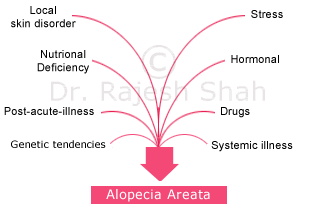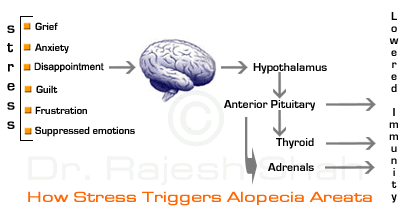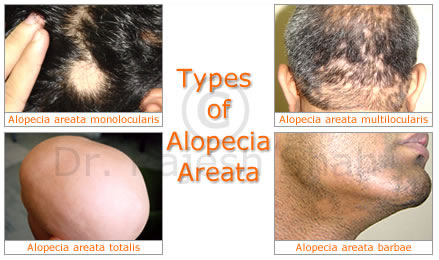Life Science Demo
Contents
[hide]Overview
Alopecia areata (‘baldness in spots') is a form of hair loss, usually from the scalp, although it can affect other areas of the body. The hair loss mostly remains limited to the scalp but in certain cases it can extend to eyebrows, eyelashes, facial hair (beard, moustache), nasal hair and give rise to bald spots anywhere in the body.
Alopecia can affect both men and women and it is not uncommon to see children affected with this disorder. Approximately 2% of the general population worldwide suffers from alopecia areata.
Understanding alopecia areata: The hair is made up of a protein called keratin which is also the main constituent of nails. A specialised structure inside the skin called ‘Papilla' produces the hair as shown in the figure. The papilla is surrounded by a sac-like structure called the ‘Hair follicle' which also surrounds rest of the hair root within the skin. The part of the hair outside the skin surface is called as shaft. Source
Alopecia areata is considered to be an auto-immune condition in which the immune system of the body (which protects the body from bacteria and viruses) mistakenly attacks the hair follicles and destroys them. This leads to hair loss in the affected area.
The commonest presentation of alopecia areata is appearance of bald patches on the scalp. In most cases, hair falls out in small, round patches about the size of a small coin. The patient may have single or multiple such patches. In some cases these patches may remain static, whereas in some cases the patches may spread to involve larger areas of the scalp. In some cases, hair loss is more extensive. Although it is not very common, the disease can progress to cause total loss of hair on the head (alopecia areata totalis) or complete loss of hair on the head, face, and rest of the body (alopecia areata universalis).
Causes
Alopecia areata is considered to be an auto-immune condition in which the immune system of the body (which protects the body from bacteria, viruses, allergens, etc.) mistakenly attacks the hair follicles and destroys them. This leads to hair loss in the affected area. This abnormal behavior of the immune system is understood to be guided, influenced and triggered by multiple factors.
The exact cause, why hair follicles undergo this kind of destruction, is not known but a genetic component to this is suspected. Family history of alopecia areata or any of the other auto-immune diseases (such as hypothyroid, diabetes, cancer, ulcerative colitis, rheumatoid arthritis, etc.) is often seen in many cases, suggesting a role of genetic element. In addition to the genetic predisposition, certain triggering factors may bring on the onset of this condition. Prolonged underlying stress often predisposes some patients to develop auto-immune process leading to alopecia areata. However, stress may not be the cause in every case.
Some other common causative factors that can contribute to the development of alopecia areata have been mentioned below: One or more of the following factors may be found responsible in cases of alopecia areata:
- Hormonal cause: High levels of the male hormones (in men as well as in women) can trigger the onset of alopecia
- Thyroid disorders
- Drugs and medications:
- Commonest is this group are chemotherapy drugs, certain medicines used for gout, arthritis, depression, hypertension, ischemic heart disease, etc
- Large doses of Vitamin A can also trigger alopecia
- Oral contraceptive pills
- Chemical treatment of hair, exposure of hair to excessive heat
- Low levels of iron
- Poor protein intake
- Physical stress: After undergoing some major surgery, or due to some chronic illness, rapid weight loss due to dieting
- SLE (Systemic lupus erythematosus)
- Fungal infection of the scalp
Types of Alopecia areata
- Alopecia areata monolocularis : In this condition there is a single bald spot on the scalp.
- Alopecia areata multilocularis: In this condition there are multiple bald spot on the scalp.
- Alopecia areata totalis : In this condition, the patient loses all the hair on the scalp.
- Alopecia areata universalis : In this condition, all body hair, including pubic hair, is lost.
- Alopecia areata barbae : In this condition, the disease is limited only to the beard region.
- Traction alopecia : In this condition, alopecia develops along the frontal margins and temporal margins of the scalp due to constant tension on the hair from being tied very tightly.



